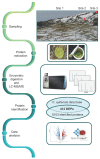Environmental Signals Act as a Driving Force for Metabolic and Defense Responses in the Antarctic Plant Colobanthus quitensis
- PMID: 36432905
- PMCID: PMC9695728
- DOI: 10.3390/plants11223176
Environmental Signals Act as a Driving Force for Metabolic and Defense Responses in the Antarctic Plant Colobanthus quitensis
Abstract
During evolution, plants have faced countless stresses of both biotic and abiotic nature developing very effective mechanisms able to perceive and counteract adverse signals. The biggest challenge is the ability to fine-tune the trade-off between plant growth and stress resistance. The Antarctic plant Colobanthus quitensis has managed to survive the adverse environmental conditions of the white continent and can be considered a wonderful example of adaptation to prohibitive conditions for millions of other plant species. Due to the progressive environmental change that the Antarctic Peninsula has undergone over time, a more comprehensive overview of the metabolic features of C. quitensis becomes particularly interesting to assess its ability to respond to environmental stresses. To this end, a differential proteomic approach was used to study the response of C. quitensis to different environmental cues. Many differentially expressed proteins were identified highlighting the rewiring of metabolic pathways as well as defense responses. Finally, a different modulation of oxidative stress response between different environmental sites was observed. The data collected in this paper add knowledge on the impact of environmental stimuli on plant metabolism and stress response by providing useful information on the trade-off between plant growth and defense mechanisms.
Keywords: Colobanthus quitensis; MS/MS analysis; differential proteomic analysis; environmental signals; enzymatic activity; gene expression analysis; response to stress.
Conflict of interest statement
The authors declare no conflict of interest. The funders had no role in the design of the study; in the collection, analyses, or interpretation of data; in the writing of the manuscript, or in the decision to publish the results.
Figures








References
-
- Convey P., Coulson S.J., Worland M.R., Sjöblom A. The importance of understanding annual and shorter-term temperature patterns and variation in the surface levels of polar soils for terrestrial biota. Polar. Biol. 2018;41:1587–1605. doi: 10.1007/s00300-018-2299-0. - DOI
-
- Clemente-Moreno M.J., Omranian N., Sáez P., Figureueroa C.M., Del-Saez N., Elso M., Poblete L., Orf I., Cuadros-Inostroza A., Cavieres L., et al. Cytochrome respiration pathway and sulphur metabolism sustain stress tolerance to low temperature in the Antarctic species Colobanthus quitensis. New Phytol. 2020;225:754–768. doi: 10.1111/nph.16167. - DOI - PubMed
-
- Wasley J., Robinson S.A., Lovelock C.E., Popp M. Climate change manipulations show Antarctic flora is more strongly affected by elevated nutrients than water. Global. Change Biol. 2006;12:1800–1812. doi: 10.1111/j.1365-2486.2006.01209.x. - DOI
Grants and funding
LinkOut - more resources
Full Text Sources
Molecular Biology Databases

